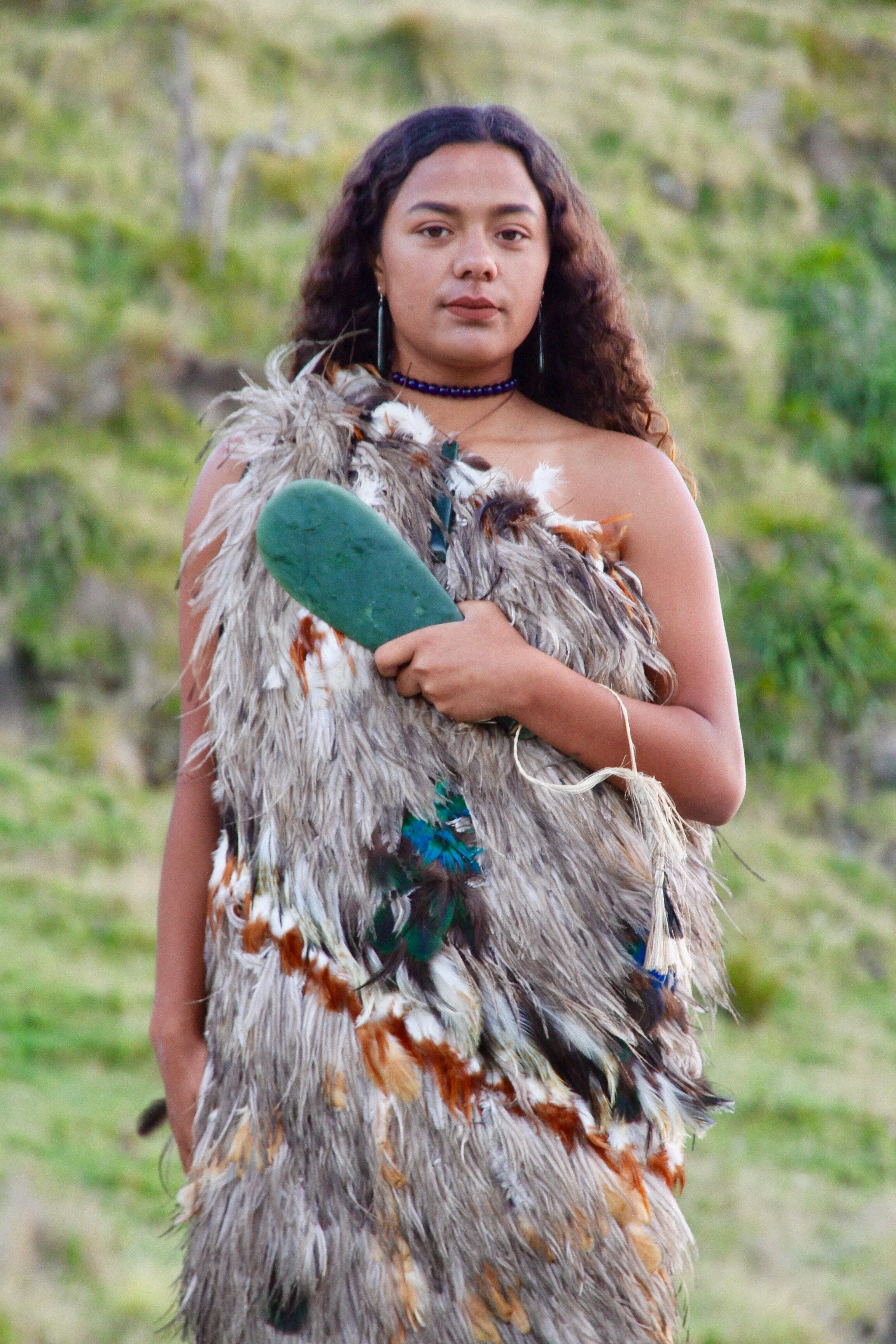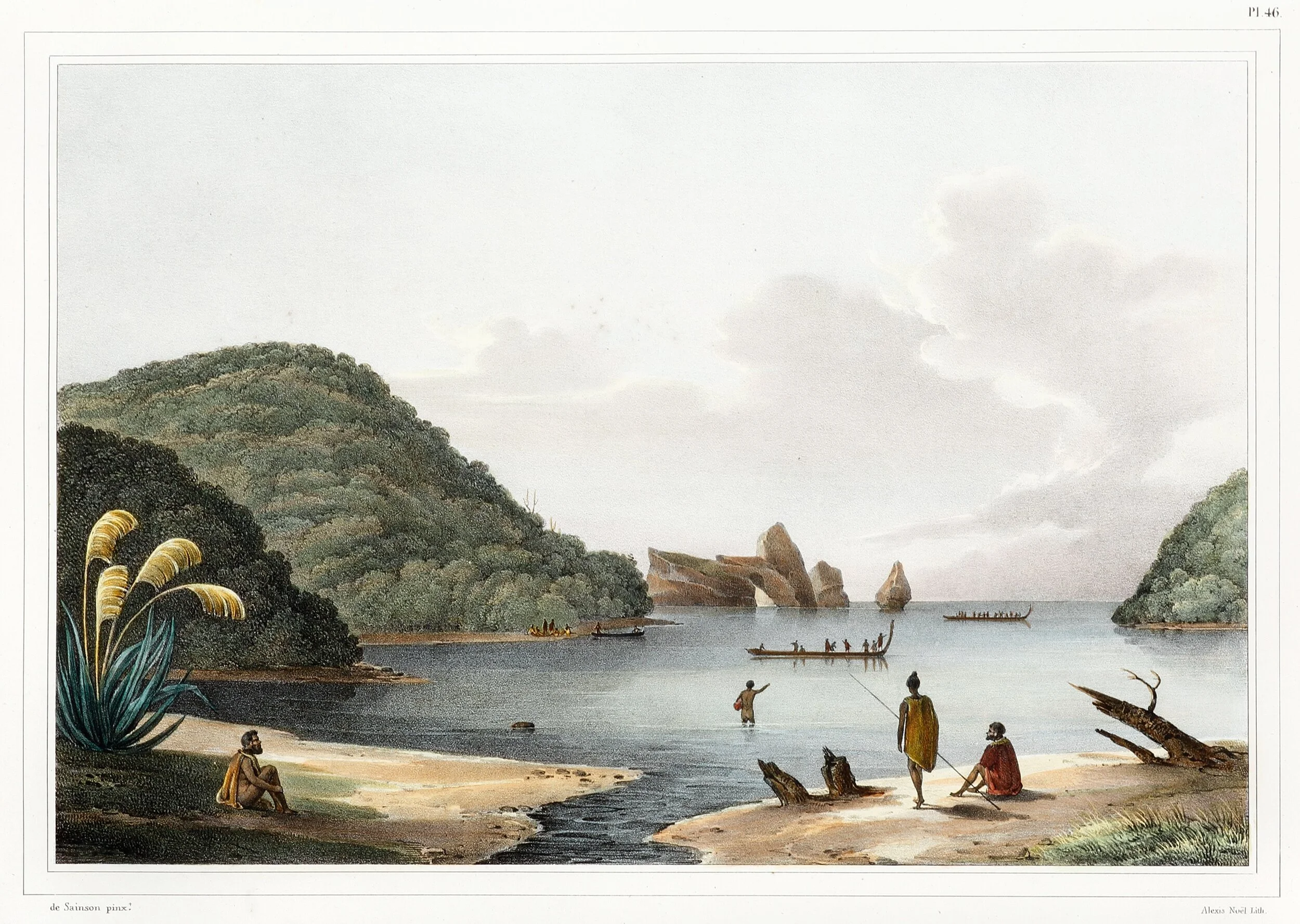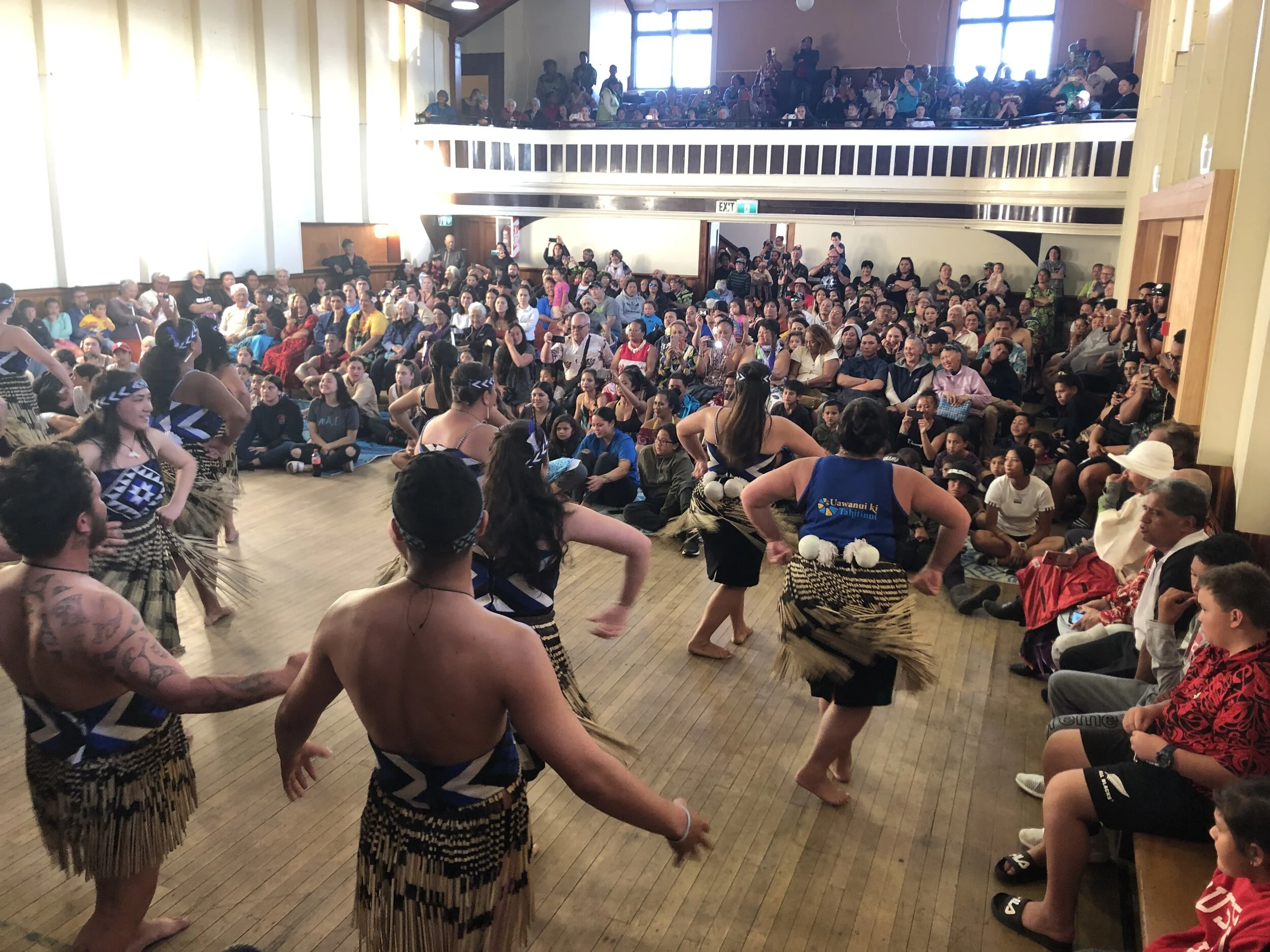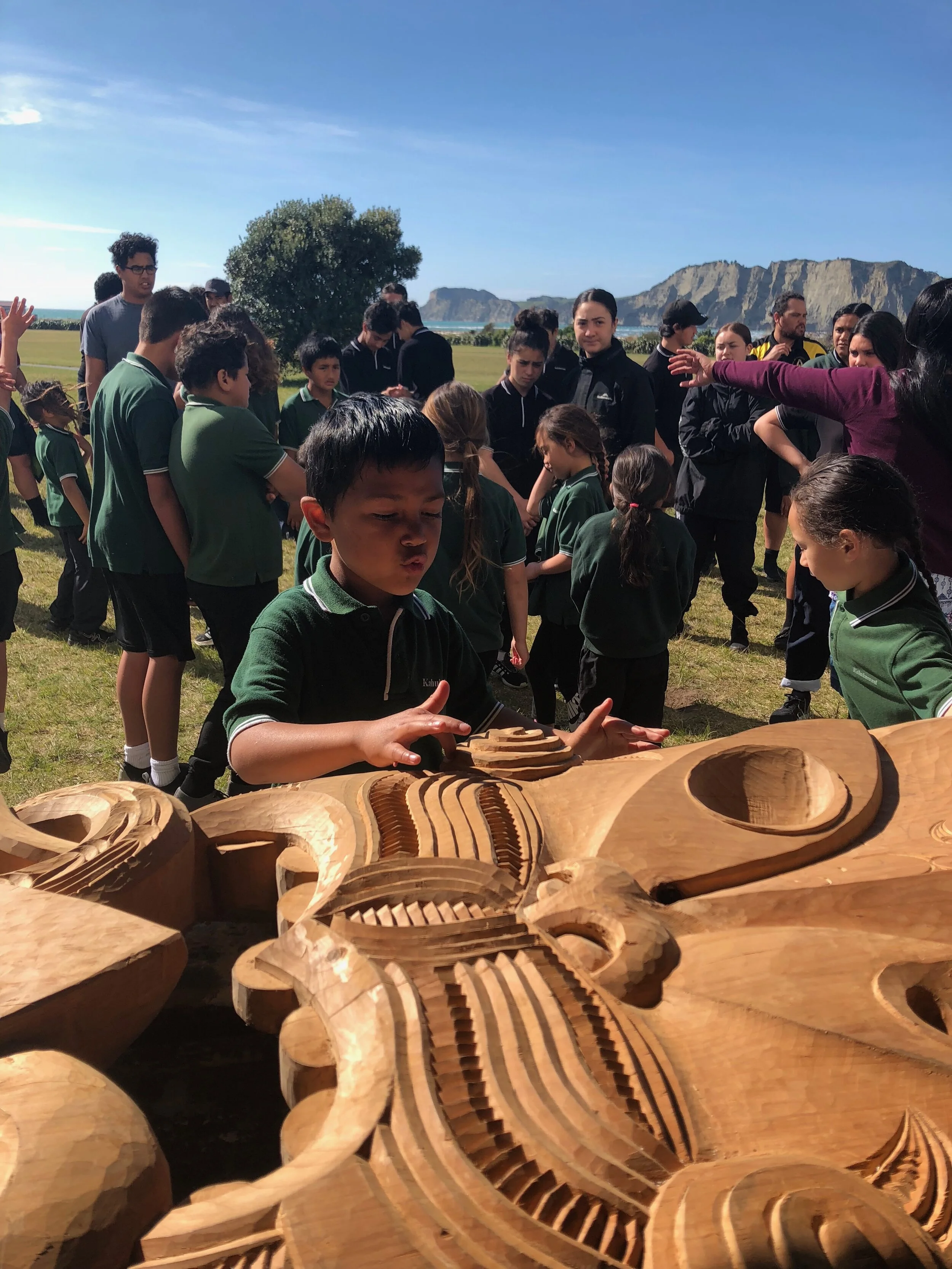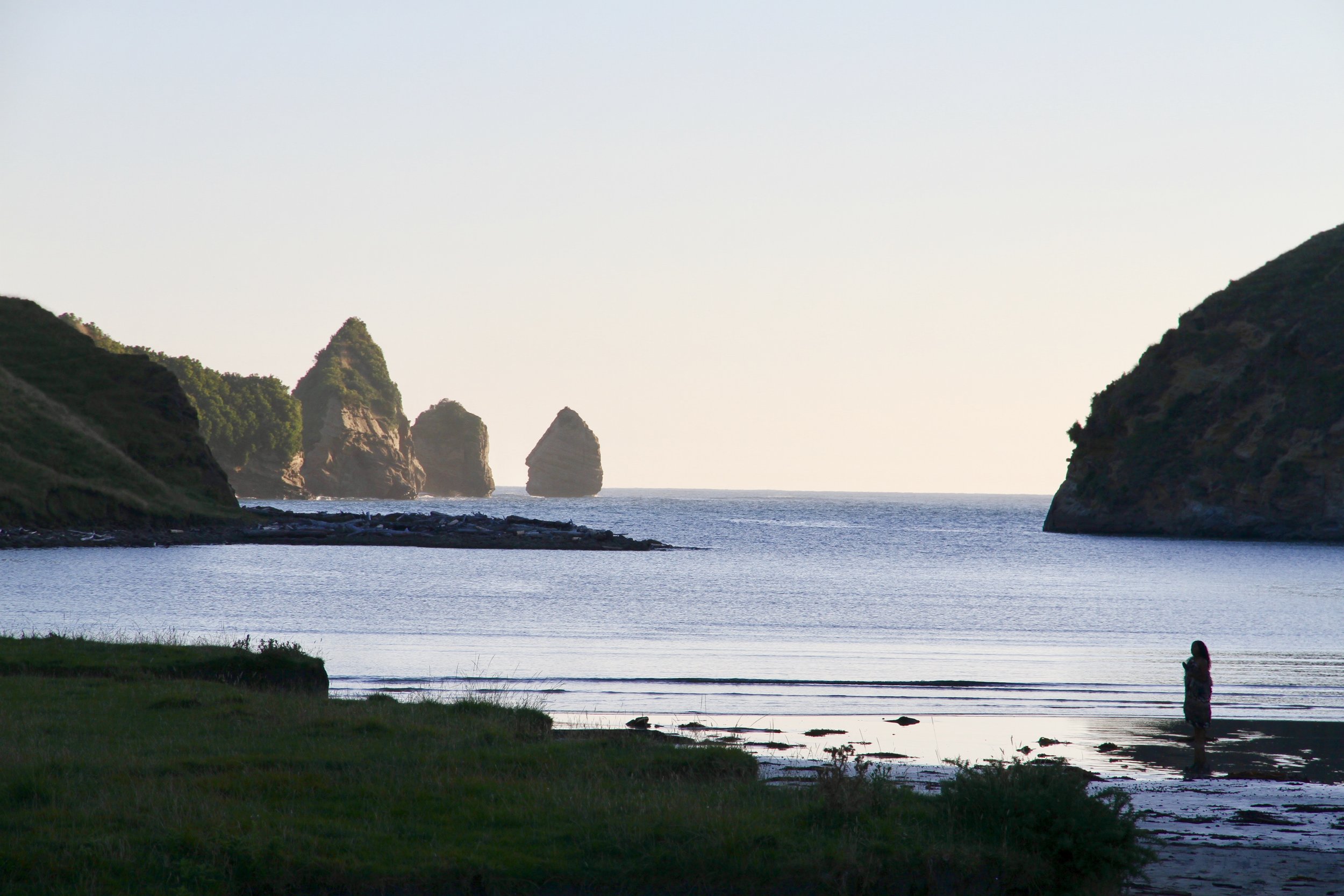“Tēnei te reo karanga ki ngā manuhiri o Te Ao, kia nau mai kia haramai rā! ”
Te Aitanga a Hauiti
Te Aitanga a Hauiti is the tribe descended from the eponymic ancestor Hauiti who lived c.1500 in the Uawa, Tolaga Bay area. His children and their descendants spread south to Gisborne and as far north as Tokomaru Bay. They organised themselves in hapū (sub-tribes) bound by whakapapa (genealogy) and attachments to particular locations.
Te Aitanga a Hauiti and the Uawa Community blessing the Te Pourewa site in 2017. Image by Krystal Garrett.
Hingangaroa and iranui
Hingangaroa Whakairo, gifted by Toi Māori
to Te Aitanga a Hauiti
Hauiti was born the youngest son of Hingangaroa and Iranui. Hingangaroa, a descendant of Maui, Paikea, Toi and others was a celebrated artist & craftsman of his era.
He established Te Rāwheoro School of Learning that stood at Mangakūkū, inland of Ūawa. The curriculum of this school was centred on whakapapa, tribal lore and the development and promotion of the arts with a focus on the history and significance of ancestors such as Tangaroa, Tāne, Ruaumoko and others on an integral part of the learning.
The first wife of Hingangaroa was Tamateataharoa. The descendant of this marriage continue to live in and about Uawa and are the Ngati Hauariki and Ngati Kuranui Hapu. His second wife was Iranui who was a daughter of Tamatea of Takitimu waka tradition & Iwipūpū, and sister of Kahungunu.
The older son of Hingangaroa and Iranui were Taua the eldest, and Mahaki Ewe Karoro who contributed to the formation of the tribes Te Whanau-a-Apanui of the Te Kaha region and Ngati Porou of the Waiapu respectively.
The fame of Hingangaroa attracted experts from all parts of the East Coast. The lament of Rangiuia last high priest of Te Rāwheoro attests to this;
Te Whare Wānanga o Te Rāwheoro in modern times
“And Manutangirua had Hingangaroa
He who established the school, Te Rāwheoro
And creativity & knowledge flourished in Uawa.
There came in payment, Te Ngaio-Tū-Ki-Rarotonga and
was exchanged for the Manaia & Taowaru
and the designs we taken north”
hauiti tipuna
Hauiti married twice, his principal wife was Hinekahukuraiti, a daughter of Rongowhakaata. Hauiti also married Rākaumanawahē, a daughter of Uepōhatu and they had two children. He chose his son Kahukuranui as his successor to lead his people and divided his land among all his children.
Hauiti and his children consolidated their interests in and about the Uawa region and while there were internal & external challenges for tribal leadership, Te Aitanga-a-Hauiti remained as the guardians of the land and of their coastal areas & fishing places, and this remained intact & in full force eleven generations after Hauiti to the time of the great leadership of Hinematioro and her cousin Te Whakatatare-o-te-rangi. It was in their time that captain James Cook arrived in Uawa in 1769.
uawanui a ruamatua - 1769
A re-enactment of 16 year old Hinematioro in 1769
Te Aitanga a Hauiti recall the time of Cook’s visit as one when they were settled people living in an abundant landscape. At this time Uawa was an important political & educational centre of Tairāwhiti.
Hinematioro was without peer in her lifetime and administered kindly to her people. Her influence went beyond her immediate tribal boundary and her stature of Ariki was recognised throughout the land. She was considered by the early European settlers to be the “Queen of the coast” and evidently was a young woman of great power & influence when Cook arrived.
Hinematioro and her cousin hosted the Tahitian navigator, Tupaea, sanctioned the provisioning of the Endeavour and the collection of 120 plant specimens. She gifted a pou whakairo from her home to Cook. The plants are kept at the British Museum of National History in London and the Pou found its way to Tübingen University in Germany.
The leadership of Hinematioro & Te Whakatatare-o-te-rangi was to descend to and express itself in their mutual grandson and heir, Te Kani-a-Takirau, who led Te Aitanga-a-Hauiti until he died in1856.
In August 1768 James Cook departed aboard HMS Endeavour from Plymouth, England on a voyage to the south Pacific. His primary purpose was to observe in Tahiti, in June 1769, the Transit of Venus across the sun. A second purpose made known to Cook in secret instructions that he opened after the observations of the Transit, was to search for evidence of the much sought after Terra Australis Incognita or ‘Unknown Southern Land!’
While observing the Transit of Venus in Tahiti, Tupaea, the Tahitian chief & expert navigator joined the crew of the Endeavour at Manavai. Tupaea was from Raiatea and was to play a critical role of communicator & mediator in Uawa. The Endeavour sailed south. They did not locate the ‘Southern Land’ but they did site and land in Aotearoa, which had been inhabited by Maori some 1000 years previous. The Endeavour made landfall at Tūranganui-a-Kiwa (also known as Gisborne) on October 9th 1769. Shortly thereafter he continued on to Anaura before making arriving in Ūawa.
After spending a week at Opoutama, Uawa (latterly known as Tolaga Bay) Cook circumnavigated Aotearoa then departed for the East Coast of Australia.
Te Aitanga-a-Hauiti promotes the encounter with Cook in Anaura & Uawa as the first positive meeting between Maori & Pākehā.
At the time of Cooks arrival and anchorage at Opoutama, Uawa was a settled region of peace but capable of defence & the protection of resources. Te Aitanga-a-Hauiti society was predicated on a belief system based on the deities of the natural world. This, combined with the strategic political acumen contributed to the leadership which was determined & validated by a sophisticated array of inter-related Hapū relationships.
The basis of Hapū leadership was from the eponymous ancestor, Hauiti & who best could manage a collaborative relationship regime that promoted the wellbeing of the people relevant for their time and their situation.
watch ‘Te ara tapu o nga tipuna’
This short documentary was produced 2004 by Tolaga Bay Area School students Hana Parata-Walker, Dexter Waru and Sarah Pethybridge. It tells the story of the arrival of Captain Cook to Uawa in 1769, and the impact this encounter had on the local iwi, Te Aitanga a Hauiti.
Te Aitanga a Hauiti Centre of Excellence and Te Ahikā thank:
Trust Tairawhiti, Eastern & Central Community Trust, Department of Internal Affairs, Department of Conservation, Tuia 250, Hauiti Incorporation, Nga Marae o Te Aitanga a Hauiti, Te Runanganui o Ngati Porou, Tolaga Bay Area School & Kahukuranui, Te Whare Hauora o Te Aitanga a Hauiti, Te Aitanga a Hauiti Kapa Haka, Uawa Tiaki Tai, Te Whare Tū Tauā o Kahukuranui, Ngā Watene Māori (Uawa Branch), and Uawanui Sustainability Project.





